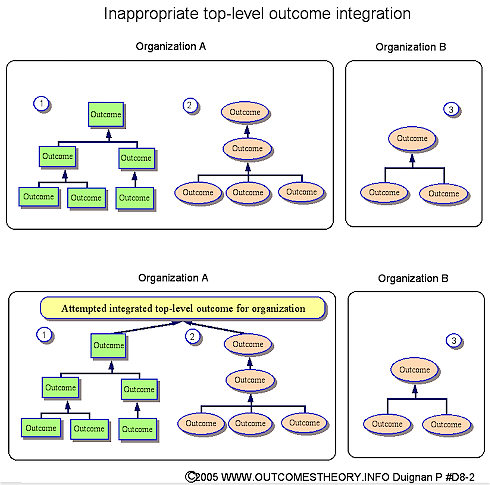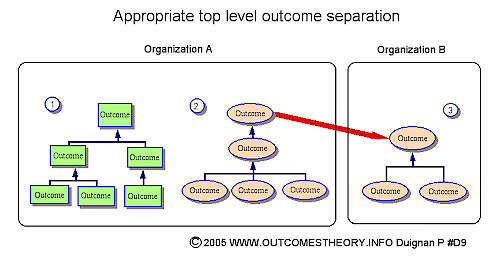Principle: High-level outcome set completeness - A control organization's overall outcomes hierarchy needs to include at its highest level the full set of outcomes which a control organization is seeking to achieve including those which involve trade-offs. [Provisional only].
Discussion: This principle applies to the overall outcomes hierarchy which a control organization is attempting to achieve. Control organizations often delegate the achievement of parts of their overall outcomes hierarchy to separate intervention organizations.
Principle: Full set of sub-outcomes hierarchies delegation or direct intervention by a control organization - A control organization must either delegate or directly intervene in the full set of sub-outcomes hierarchies which make up the control organization's overall outcomes hierarchy.
Discussion: If a control organization does not either delegate or directly intervene in the full set of sub-outcomes hierarchies which go to make up its overall outcomes hierarchy then it is unlikely to full achieve its overall outcomes hierarchy.
Principle: High-level outcomes trade-off identification - If there are trade-offs to be made between the achievement of high-level outcomes within an outcomes hierarchy, these need to be identified by the control organization.
Discussion: If a control organization does not identify trade-offs to be made between the achievement of high-level outcomes within an outcomes hierarchy, it may, without realizing it, delegate to an intervention organization decision-making in regard to these trade-offs. This may mean that it does not end up with the achievement of its preferred mix of high-level outcomes within its overall outcomes hierarchy [Provisional only].
Principle: High-level outcomes trade-off delegation - When there is one or more trade-offs between the high-level outcomes within a control organization's overall outcomes hierarchy, it has three choices: firstly, it can delegate the achievement of the whole overall outcomes hierarchy to one intervention organization and in doing so effectively delegate decision-making around trade-offs between the high-level outcomes; secondly, it can delegate sub-outcomes hierarchies which do not contain the trade-offs to different intervention organizations and manage the trade-offs by applying either positive or negative sanctions to the intervention organizations; thirdly, it can directly intervene in a sub-outcomes hierarchy as a way of managing the trade-offs with high-level outcomes in another sub-outcomes hierarchy it has delegated to an intervention organization.
Principle: Single integrated top level outcome not a necessary requirement for an intervention organization's outcomes hierarchy - Since outcomes hierarchies as conceptualized within outcomes theory are about 'cascading sets of causes in the real world' there is no necessary requirement that an intervention organization have at the top of its outcomes hierarchy a single integrated outcome.
Discussion: It is often mistakenly assumed that at the top of the outcomes hierarchies which an intervention organization is attempting to influence, that there should be a single integrated outcome covering all of the activity of the entire organization. This perspective views outcomes hierarchies as being about, the often somewhat arbitrary, lines of demarkation between organizations. If an organization is just working on a single outcomes hierarchy and at the top of that outcomes hierarchy there is a single outcome, then it is appropriate for there to be a single outcome at the peak. However, in the real world, intervention organizations are often delegated a number of sub or whole outcomes hierarchies to achieve, sometimes by more than one control organization.
In the diagram below, Organization A has been asked by its control organization to intervene in two conceptually different outcomes hierarchies (outcomes hierarchies 1 and 2). Organization B has been asked by either the same, or a different, control organization to intervene in outcomes hierarchy 3 which in the real world is a sub-outcomes hierarchy of the larger outcomes hierarchy to which outcomes hierarchy 2 also contributes.
It is a mistake for Organization A to attempt to develop a substantive integrated top-level outcome for the organization which attempts to artificially unite the content of outcomes hierarchy 1 and 2; as is illustrated at the bottom of the diagram below. It is possible for Organization A to state a nominal generic top-level outcome which goes along the lines of 'being successful at intervening in the outcomes hierarchies which are required by our control organization(s),' however, this does not provide any additional analytical power to the outcomes hierarchies below it.

A preferable approach is for Organization A to have two separate outcomes hierarchies in which it is attempting to intervene and for it to then discuss with Organization B how a joint outcomes hierarchy can be developed between the two organizations composed of the outcomes hierarchies 1 and 2, with 1 and 2 viewed as sub-outcomes hierarchies of a more comprehensive overall outcomes hierarchy. This is set out in the diagram below.

Example: This situation occurs in many cases where a government allocates to a public sector intervention organization a number of conceptually separate outcomes hierarchies.
Principle: Optimal allocation of outcomes hierarchies to intervention organizations - The optimal allocation of sub or whole outcomes hierarchies to intervention organizations is the one which produces the greatest average outcome cross-linkage density within each intervention organization. [Very provisional only].
Discussion: [Special Note: This principle requires significant additional work to ensure it is sound]. In a situation where a control organization has to delegate a number of conceptually distinct outcomes hierarchies to a number of intervention organizations it is presented with a difficult optimization problem. Within outcomes theory, the solution to this problem to maximise the average outcome cross-linkage density within each intervention organization. Put simply, this means that the control organization is attempting to focus each intervention organization on a set of activities which have the most in common with each other. So as a way of proceeding the following steps can be taken:
1) The control organization draws up all of the outcomes hierarchies which it is interested in (often a very major exercise for a control organization with wide scope).
2) If there are a number of separate outcomes hierarchies with a high outcomes inter-connection which are going to require major resource input, they can be allocated to a set of individual intervention organizations.
3) Relatively separated smaller outcomes hierarchies can be assigned to one or more additional intervention organizations.
4) Significant outcome inter-connections between separate outcomes hierarchies can be deal with by putting in place effective outcome achievement liaison processes between intervention organizations.
Example: Government central control agencies have the most significant challenge in this area as they attempt to work out what is the best allocation of sub and whole outcomes hierarchies to the range of intervention organizations they are responsible for structuring. Difficulties with this optimization problem lead to the phenomena seen in some countries of a constant restructuring of public sector organizations. The same problem is faced by Chief Executives within large organizations as they attempt to identify the best structure for their organization.
V1-1.
